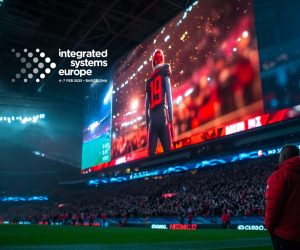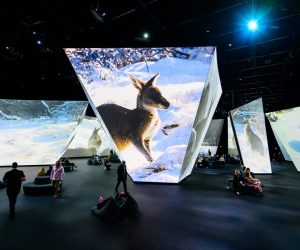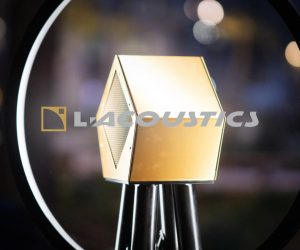
Hive Mind
The Curtin HIVE visualisation centre is now the home of the first Digital Projection Satellite MLS installation.
Text:/ Christopher Holder
You’ve got to hand it to whoever came up with the acronym. The Curtin HIVE stands for ‘Hub for Immersive Visualisation and eResearch’ and ‘HIVE’ is a highly evocative way of considering what’s on offer: a veritable cornucopia of visualisation systems for researchers at Curtin University to engage with data more effectively.
Some five years after the HIVE was established in 2013, a couple of the projection systems were getting stale, well out of warranty, and, in the case of the projectionDesign units, the manufacturer no longer even existed.
In 2019, the university asked InDesign Technologies to investigate their options for a display technology upgrade for two of the visualisation systems: The Cylinder — a 180° immersive projection system; and The Dome — an immersive four-metre diameter half-dome screen.
As part of the market research, Associate Professor and Manager of Curtin HIVE, Andrew Woods, attended a product demonstration by Manchester-based company Digital Projection. One thing led to another, as they say, and the HIVE eventually became the world’s first Satellite MLS installation. But first, what’s Satellite MLS?
SATELLITE FEED
The Satellite Modular Laser System separates the laser light engine and control electronics from the projector ‘Head’. Joining the two is (up to 100m) of shielded fibreoptic cable.
If this is the first time you’ve heard of SMLS, then immediately you’ll be thinking ‘Ahh, that’s actually really smart’. And you’d be quite correct.
The principal advantages of leaving most of the projector in the rack room are:
Weight: A large projector can easily be 120kg+ and be an enormous arse to hang in the air, requiring three or more burly techs. A SMLS Head weighs in between 19kg and 45kg depending on the lens.
Size: The SMLS approach means the projector Head can fit in tight spots — it’s the size of a breadbox rather than the size of a doghouse.
Heat: The bulk of the heat-producing electronics are in the climate-controlled rack room.
Noise: The Head has fewer – and quieter – cooling fans.
Then there are some less obvious but equally useful advantages:
Redundancy: It’s comparatively easy to swap out a light source module if something goes wrong — way easier than pulling down a projector.
Upgrade-ability: You can double the light output by adding another laser light source feeding the same Head — no need to stack projectors. Or, a 2K Head can be swapped for a 4K Head if requirements develop. The light engines would remain unchanged.


CYLINDER ROLL OUT
If the HIVE is a visualisation ‘sandbox’ as Andrew Woods likes to describe it, then The Cylinder is the cool Tonka truck that everyone in the sandbox wants to play with: “The HIVE Cylinder display is the flagship system in the facility,” concurs Andrew Woods. “The Cylinder display uses three projectors to light a 3m-high, 8m-diameter, 180° cylindrical projection screen. In upgrading the HIVE Cylinder display, in particular, we were keen to increase the display resolution to use native 4K projectors, which would provide a four-fold increase in displayed pixels, and to increase the brightness, all while maintaining the existing 120Hz stereoscopic 3D capability of the display.”
After Andrew Woods and his team became convinced of the advantages of Satellite MLS it had to decide on whether it was happy to effectively be the worldwide ‘guinea pig’. The upside is you have the manufacturer’s full attention. The downside is you need to work through the inevitable teething problems.
“An important advantage of Satellite MLS for us was the reduced noise. We discovered with the old projectors that when the room reached 25°C the projectors’ fans went into overdrive. It would get so loud that occasionally we’d have people request we switch the projectors off, and in a visualisation space you’ve got to ask yourself — what’s the point? Now, having a much quieter environment, makes for a huge improvement in the experience.”
Serving up the visuals is a chunky dual-Xeon server-grade PC with three NVIDIA Quardro RTX8000 graphics cards. A 5.1 audio system enhances the experience. Some 50 people seated or 25 standing can be involved.
“We did consider a 360° system when we originally designed the HIVE but in my experience they’re not as effective. There’s no focus, as such. You can fall over other people because you’re all looking in different directions.”
SATELLITE MLS COMPONENTS
The Projector Head is compact, quiet, light-weight and consumes little power. Depending on the lens it weighs between 18kg and 40kg. The Digital Projection promise is that the Head “simplifies and improves every stage of a system design, from transportation and installation to serviceability and lifespan”. Up to 100m of fibreoptic links the Head with the light source.
The Modular Light Source is a self-contained pure RGB Laser module with no external chiller. Each module produces 10,000 lumens and has a built-in touch panel control to allow for quick and easy set-up and operation. Weighing under 25kg, this module will fit in any standard rack module and is only 4U high. You can connect multiple light sources to a single head for extra brightness or attach multiple heads to the one light source.

HOME TO THE DOME
The HIVE Dome display was the other beneficiary of a Digital Projection Satellite MLS upgrade. The Dome is a one-person visualisation tool that fills the user’s entire primary and peripheral field of view. It’s actually more enveloping than a 3D headset and has the advantage of allowing other observers to see what the main user is seeing. In this install, the Satellite MLS Head employs a fisheye lens while The Dome software distorts the image such that the geometry is correct when it hits the screen.
Andrew Woods describes how it might get used: “We had a research project use the Dome to test balance, vision and attention in subjects with autism spectrum disorder. Subjects stood on a force place, a bit like a Wii Balance Board, which detects if their weight is leaning forward or backwards as The Dome displayed moving content. The project compared the reasons of people with ASD and a control group, and demonstrated how something like The Dome could be used as a diagnostic tool in the future.”
WHAT’S IN THE HIVE?
The display facilities at the HIVE, located in a 15m × 15m former gallery space, comprise the Dome display, a 4m-diameter half-dome which fills a user’s primary and peripheral field of view; the Cylinder display, a wrap-around 3D display providing a VR experience for up to 50 users; the Wedge display, a pair of 3.8m diagonal 3D displays used mainly for scientific visualisation; the Tiled display, which with 24MP resolution is used for super high-resolution visuals; and the Hologram Table from a Brisbane company called Euclidean Holographics, which provides two users with 3D visuals that project out of and into its tabletop display surface. The upgrade project focused on the Dome and the Cylinder displays.

HOW’S IT TO INSTALL?
Curtin University engaged Vizcom to take care of the installation and integration of the new gear, with Scott Wrightson leading the team. He reflects on working with a brand new technology and what it means to halve the weight you need to lift into the ceiling.
Scott Wrightson: Satellite MLS is a fantastic advancement. All the hot and noisy parts of the hardware are contained within the comms room and made for an easier installation. The Heads are about 40kg, so that’s not insignificant, but we could install those with an EWP and two people. The equivalent all-in-one projector comes in at 120kg, which would have meant having another person on the lift and probably another securing the projector to the bracketry.”
This was the first Satellite MLS install so Scott and his team were keen to be super careful:
“We were advised to be careful. But we found that it came together without needing kid gloves. Anytime you work with fibre you need to be careful but nothing more than that.”
So does he see Satellite MLS finding a wider audience?
Scott Wrightson: “If you’re in a space like the HIVE where you need low ambient noise, then the Satellite MLS system is second to none. If you’ve got the comms room to house the central laser source, then I can see plenty of scope for where a Satellite MLS would be beneficial, especially in the corporate environment. If a client is willing to go up to this level of projection, then I could definitely see Satellite MLS being a far superior solution to a lot of the other projectors on the market.”
For a facility that relies on high-impact visuals to complement the University’s high-quality research, the Satellite MLS has been the perfect choice for the HIVE.















RESPONSES